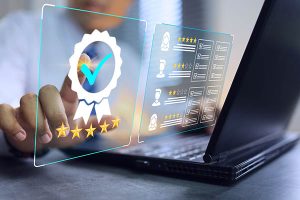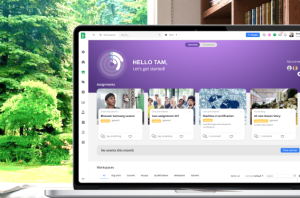This article defines enterprise learning management and helps you assess whether you have the right tools and systems in place to make your learning program a success.
Learning is a key component of any role, but delivering effective learning on an enterprise scale is inherently much more complex, so how is this achieved at the enterprise level? This article defines enterprise learning management and helps you assess whether you have the right tools and systems in place to make your learning program a success, to help improve employee performance and thus your company’s competitiveness within its market.
What is enterprise learning management?
Enterprise learning management is the process of managing learning and training in an enterprise-sized organization. It helps you deliver outstanding training programs on a large scale and monitors the progress of this with complete visibility and data-driven results.
With enterprise learning management, you can upload content, schedule training, allow flexibility for when learners complete the course and manage all training and accreditation documentation online. This all takes place on a large scale, sitting across many different departments.
What makes enterprise learning management systems different from other learning management systems is that they’re designed around the needs of huge organizations. They organize and manage high numbers of new hires, complex work schedules and specific hierarchical structures. All of this is frequently achieved on a global scale.
What you need to consider to deliver an effective enterprise learning management program
Every organization is different. We invite you to analyze your current methods for training and ask yourself if you can currently achieve the following:
1. Can your training program keep up with the rate of your digital transformation?
Enterprise-sized companies are rapidly adopting new technologies to reduce their expenses and run their key business operations. Their very nature means that they’re often working concurrently on many different digital transformation projects to drive their technical vision forwards.
If you still rely on an inflexible training model that involves paper, manual spreadsheet input, or fishing through e-mail trails to check someone’s certification status, you can’t keep up with rapidly evolving technology in your sector. Falling behind on the tech side may mean you can’t keep up with customers’ expectations. Zippia research revealed 56% of CEOs said digital improvements have improved their profits.
There’s a new generation of workers who were thrown into the post-pandemic world of integrated technology with workplace operations. They quickly became accustomed to working in the cloud on platforms such as Microsoft Teams, Slack, and Zoom. They love the speed and fluidity that collaborative cloud apps deliver. They won’t be familiar with clunky training methods that are rigid and inflexible. This could hold back their productivity. This prevents them from adopting a fast and seamless training process that ensures they’re fully equipped with everything they need to perform their role efficiently.
2. Do your current processes keep up with your organization’s growth?
There are expected to be 130,000 new jobs created in life sciences by 2030 in the UK alone. Other sectors echo this growth trend. Research from a UK government report explored how there will be 250,000 new jobs created in the green manufacturing and energy sector by 2030 because of increased investments and the drive towards net zero carbon emissions.
Conducting training manually with in-person classes, standardized training with no opportunities to customize it, and note-taking on paper are highly time-consuming and repetitive. What if new starters are sick when you deliver training, is it easy to catch them up with the rest of the team? Can you measure engagement levels on a mass scale the same way an enterprise learning management system can?
3. Can you track the training process for a remote, globally dispersed team?
In an enterprise-sized organization, it’s hard to put names to each face in a sea of people. In the context of learning, everyone is different. For some people, certain modules will be a breeze, whereas others need to take more time studying. How can you meet the needs of all employees if everyone is scattered around the world?
While you can make use of Zoom video calls, you have to find a time that everyone is available and it’s an appropriate time in their time zone. A fully loaded enterprise learning management system contains training event management capabilities with scheduling and planning functions to make this seamless.
A purpose-built enterprise learning management system delivers full accessibility to training from any location because it’s cloud-based. This means learners can work how they like and learn at a pace that works for them. You can see results and check in with those who need additional support.
4. Do you find it easy to roll out Continuous Professional Development? (CPD)
CPD is an ongoing structured learning process that’s compulsory in certain roles. The process of recording this includes formal assignments, examinations, and peer mentoring.
Doing this manually at an enterprise level is complicated, leaving you prone to mistakes, particularly if you have a complex hierarchy where specific roles require specific training.
5. How easy is it to keep up with changing industry compliance legislation?
Enterprise sized organizations in many different industries are subject to complex regulatory compliance legislation. Heavily regulated industries include financial services, pharmaceuticals, manufacturing, food processing and FMCG. Compliance levels are regularly audited and ensuring continuous compliance is time consuming and complex.
An effective enterprise learning management system makes maintaining your compliance levels easier. In particular, flexible, modular platforms make it easy to keep up with changes. They ensure that your training processes and team certification status are all fully documented in a central location. This helps you prove your certification status when you are externally audited.
6. Can you easily address skills gaps with in-house training rather than relying on recruitment?
Recruitment can be a long tiresome process trying to find one person who is ready for a new challenge and who already possesses the exact skills listed in your job advert. There could be multiple fast learners already part of your team, waiting for an opportunity to be upskilled.
You could find out who these fast learners are in a few clicks with a cloud-based enterprise learning management system. The scale of an enterprise organization means that detailed data analytics are the key to efficiency and 360-degree visibility. Your training process can be easily structured with clear goals in mind. Upskilling your team drives your business performance strategy forward.
7. How flexible are your current training processes?
The aim of your training and learning processes is to equip your team with the skills they need to perform their role well. This is time-consuming if they are undertaking their day-to-day job tasks at the same time. Can they only access training from one computer in your workplace? Can multiple people access it at the same time? Do certain people need to be present for the training to take place?
Take healthcare for an example. Healthcare workers rarely have a chance to sit down during their shifts and complete an entire module in one sitting. They may have a few ten-minute periods where they can make progress in bite-sized pieces. If logging onto one computer takes too much time, you’ll need a faster, mobile-friendly solution that can be accessed anywhere.
8. How long do you spend manually creating reports?
How do you measure your engagement levels to know what methods work well with your learners? If you find yourself second-guessing your Return on Investment, then it’s time to automate your reports.
These reports show:
- Who’s falling behind?
- Who’s completed compliance training?
- Current skills gaps
- Average course completion duration
- Documented certification levels
- Upcoming training program
With an enterprise learning management system, you can automate these reports at the touch of a button to accurately gauge your ROI.
How Blossom Enterprise Learning Management Platform transforms your training capabilities on a vast scale
Blossom is an enterprise learning management system that delivers operational independence and freedom to transform your resource planning, staff training and overall business performance. Purpose-built to be scalable, Blossom aligns with the needs of enterprise-sized companies, ensuring a fast integration. It’s a centralized platform which a vast array of modules, that are customizable for you. They’ve consistently delivered success in many highly regulated industries including healthcare, finance, telecoms, government, military and aviation. Their service is backed by 5-star ratings, with stacks of positive client testimonials.
Blossom’s blog contains more tips and information from the digital world for complete organisational management.








